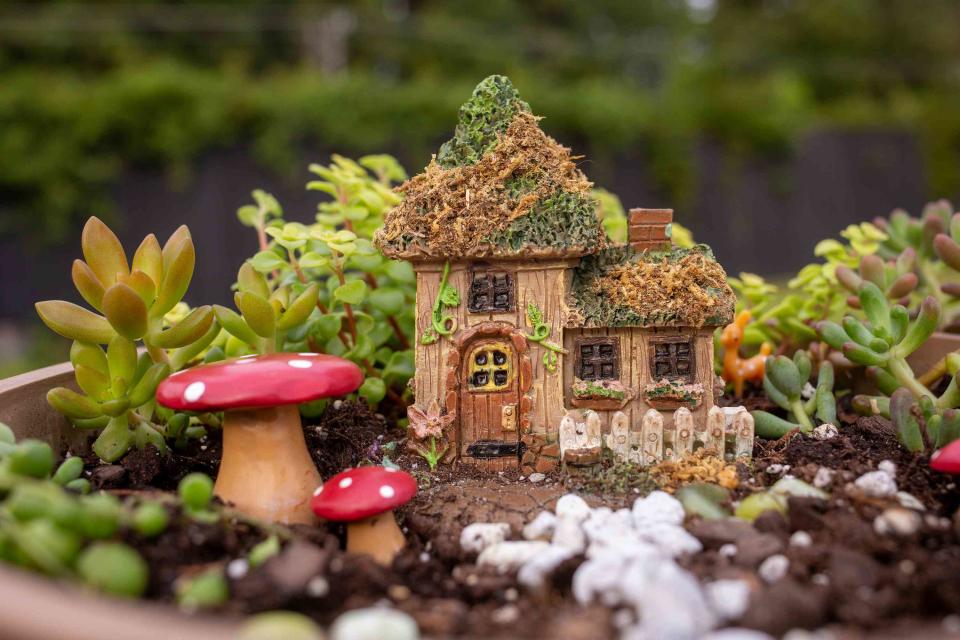Fairy Gardens Are Making a Comeback—Here’s How To Create One in Your Yard
Learn more about this whimsical approach to garden design.

Carlofranco/Getty Images
Serious gardeners might write off “fairy gardens'' as child’s play, but this dismissive attitude means they miss out on the magic of these miniature gardens. If you have an appreciation for the wonder that a woodland can inspire or a desire to express your creativity, fairy gardening has much to offer.
Abigail Stout, who runs the fairy garden-themed Etsy shop Sprouted Dreams and a YouTube channel, explains why fairy gardening remains popular (even if naysayers claim it was a passing fad). “I believe that a momentary escape from the troubles and trials of everyday life is helpful to mental health,” says Stout. “This is why I put so many details into the [fairy] homes and accessories I create. When they are gazed upon, you can lose yourself in them for a little while.”
We spoke to Stout and Janit Calvo, the author of Gardening in Miniature and owner of Two Green Thumbs Miniature Garden Center, an online retailer of tiny garden plants and accessories that emphasizes the gardening aspect of fairy gardens, to find out more about gardening in miniature and how to create a successful fairy garden.
Related: How to Grow a Year-Round Garden With Color and Interest Every Season
What is a Fairy Garden?
A fairy garden is a small garden (or corner of a garden) designed to look like an inviting spot for fairies. Fairy gardens can be in the ground or in a pot or other container.
Typical fairy gardens include miniature accessories that look like they can be used by fairies. Fairy gardening is sometimes, but not always, a subset of miniature gardening, which incorporates true miniature trees and plants to create the miniature scale.
What Do You Need for a Fairy Garden?
"A typical fairy garden should have a variety of miniature trees and plants for the fairies to hide, maybe a fairy house or a fairy fortress of some kind,” says Calvo. To help the viewer experience the scale and be drawn into the “story,” Calvo recommends including “tiny pathways going to and fro, with a wee bench or two.”
Calvo notes that there are two kinds of fairy garden accessories—those that look like they were made by the fairies (think log houses and stumps for chairs) and those that are made for the fairies (realistic mini houses and furniture that mimic our full-size world).
“Separate these two categories, then coordinate the size and scale of the accessories in each scene, or it will look like a bunch of toys in a pot, which doesn’t invite curiosity,” she cautions.
What Are the Best Accessories for a Fairy Garden?
Scale is essential when buying or making accessories for your fairy garden. “If you want a fairy house in your fairy garden, use that as a gauge to find fairy accessories that match in scale to the house. Otherwise, it will look disjointed,” says Calvo.
She adds, “In miniature gardening, we deliberately use in-scale miniatures, so the scene is genuine and real—that’s where the magic is.” Stout says that many people like to start with a simple fairy door on a tree.
What Kinds of Plants Belong in a Fairy Garden?
Use plants that will stay small for years, so you can maintain your miniature garden with minimal maintenance. “There are genuine miniature and dwarf trees and shrubs that grow slowly while looking like a big, majestic tree in miniature,” says Calvo, who sorts her plants by zone for gardeners.
“Layering down with small-leafed perennial ground covers will create a true garden in miniature,” she adds. Pre-bonsai trees, which are grown to be bonsai trees, are an excellent choice for fairy gardens.
You can also look for plants intended for terrariums, which will be small in size (just pay attention to hardiness if you’ll plant them outside). For potted plant fairy gardens, Stout likes to include some plants that drape over the side of the container, such as Creeping Charlie, String of Pearls, or Martha Washington geraniums.
Related: 27 Most Popular Perennial Flowers and Plants for Your Garden
Common Fairy Garden Mistakes
Don’t Plant too Low
When creating a fairy garden in a container, bring the garden up close to the rim. “[If you plant too low], you can’t see the garden until you’re standing above it and it’s not healthy for the plants as it doesn’t let the light and air through,” says Calvo.
Don’t Skimp on Plants
“Only relying on the fairy houses and accessories to create a fairy garden isn’t really a garden at all,” says Calvo. “If you think about what would be a natural place for any kind of fairy to reside, you need real trees and plants.”
Don’t Overdo It
“As with most creative and design projects, less is more,” says Calvo. “Using too many accessories in one scene will be cluttered, confusing and the viewer won’t come in for a closer look. If you want to buy more accessories, create different scenes for them or rotate them in and out of your miniature garden as you like.”
Related: 'Chaos Gardening' Is the Low-Maintenance Way to Grow Flowers All Season
For more Real Simple news, make sure to sign up for our newsletter!
Read the original article on Real Simple.

